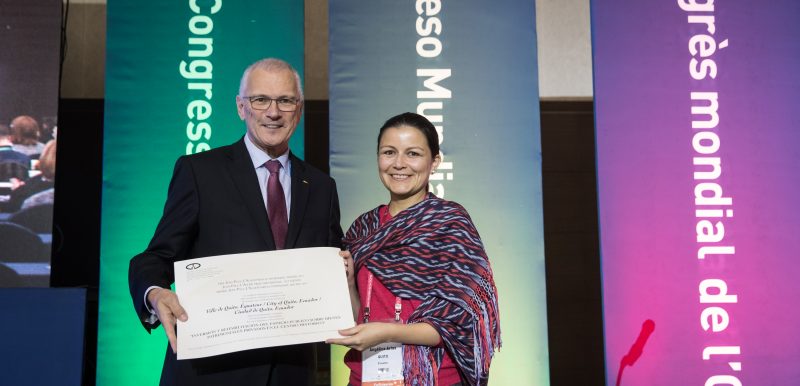Quito, Ecuador
General Information
Administrative status
National capital and chief city of the Province of Pichincha
City of Quito
Registration Year
1978
Historical function
Politics and culture
Location and site
Quito, located at about 2,800 m. above sea level, on two flanks of the Pichincha Volcano, is in the midst of the Andean landscape.
Urban morphology
The historic area of Quito is 348 hectares in area. Its planners, who were well acquainted with the Andean world, succeeded in laying out the streets on its complex topography according to the “Law of the Indies,” with blocks measuring 84 m. x 84 m., a central square at the heart of the city and a few secondary squares in carefully selected locations.
The regularity of Quito’s plan accentuated the contrast between its monumental and domestic architecture. The central square is bordered by the Government Palace, the Municipal Palace, the Bishop’s Palace and the Cathedral, and other religious buildings of the 16th to 18th centuries are spread throughout the city. The colonial dwellings, often constructed of adobe with sober whitewashed facades, are built around patios.
Registration criteria
Criterion (ii): The influence of the Baroque school of Quito (Escuela Quitena) was recognized in the cultural domain, especially art – architecture, sculpture and painting – in all the cities of the Audencia, and even in those of the neighbouring Audencia.
Criterion (iv): Quito forms a harmonious sui generis where the actions of man and nature come together, to create a unique and transcendental work of its kind.
Historical reference
- Up until the time of the Spanish Conquest in 1532, the territory known as Equador today was part of the Great Inca Empire, known as Tahuantinsuyu. The city of San Francisco de Quito was founded on the ruins of the northern capital of this empire, established a century before this time, although the occupation of the site dates to much earlier.
- As the capital of the province of Pinincha and the Episcopal See, San Francisco de Quito became the seat of royal audiences in 1563; this gave it political power over the other cities and villages under its protection. By the end of the 16th century, Quito was a crossroads for artistic influences and its art school was created. The layout of the city, which dates to that period, has been maintained to this day.
- A precursor of other South American colonies, Quito proclaimed its independence in 1809. Until 1830, it was incorporated, along with Venezuela, into Great Columbia, and served as capital of its southern region.
- The city has since expanded beyond the limits of its 19th- century colonial nucleus.
Photos
News
11 December 2017
Quito, Ecuador – Winning city of the 5th Edition of the Jean-Paul-L’Allier Prize for Heritage
Quito, Ecuador
The Jean-Paul-L’Allier Prize for Heritage
Contact
Sr. Milton Chávez Aguirre
Director Ejecutivo
Instituto Metropolitano de Patrimonio de Quito
Sr. Christian Pabel Muñoz Lopez
Alcalde
Municipio de Quito
Venezuela N5-10 y Chile, Palacio Municipal, Piso 1
Quito, Pichincha, Ecuador
140401
PBX: (593-2) 3952300
[email protected]
Dra. Daniela Alexandra Célleri Endara
Directora Metropolitana
Alcaldía de Quito
Venezuela N5-10 y Chile Edf Pérez Pallares Piso 2
Quito, Pichincha, Ecuador
170401
+593 3295300 ext: 13521
[email protected]





